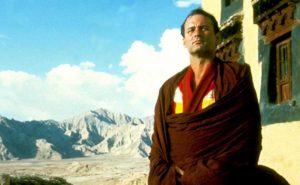One of the worst things to ever happen to the Western view of love was when a group of psychologists came together and decided to refer to close relationships as attachment bonds.
It all started in the 1930s, when a researcher by the name of John Bowlby observed that our family experience has a huge affect on our overall mental-emotional well-being. At the time, Bowlby’s research was quote innovative and ran contrary to the current psychological paradigm.
At the time, most psychologists were steeped in Freudian beliefs that focused more on ridiculous notions like Oedipal complexes and psychosexual development. Others were focused on Melanie Klein’s object relations theory that posits that children’s emotional problems are due to fantasies between aggressive and libidinal drives. But unlike his psychoanalytic counterparts, Bowlby was correct that the early emotional bonds children form with their primary caregivers have a huge effect on their development, continuing to influence their behaviors throughout the rest of their lives.
Overall, Bowlby’s research was a good thing and finally put to rest a number of psychological theories that were based on shoddy science. Bowlby was so transformative because he focused on actual family experience, rather than dreams, myths, or made-up biological drives.
Bowlby’s research was greatly expanded upon forty years later, when the psychologist Mary Ainsworth found three distinct attachment styles that can form early on in life. Ainsworth called these attachment styles secure, ambivalent-insecure, and avoidant-insecure. Later, the researchers Main and Solomon added a fourth attachment style known as disorganized-insecure.
The field integrating all this research, attachment theory, continues to expand, with lots of robust research that many psychologists, therapists, and neuroscientists use to understand human behavior. The main tenet of attachment theory is that our early relational patterns are deeply set early on in our lives by whoever took care of us when we were young. When we then enter into romantic relationships in adulthood, those same patterns reappear.
Nowadays, you can find dozens of surveys, videos, books, and articles all around figuring out what attachment style you have, and learning how to manage it and become more secure over time.
As good as attachment theory is, any time we become so focused on one way of looking at the world, we forget about other ways of seeing and understanding. I have written before about how important it is to continue to question and go beyond our common narratives, including those on the guru being within, the monkey mind, and the story of the two wolves.
Attachment theory too is not the end-all be-all of relationship research that many people would have you believe. Rather it is one way of looking at the connection between intimate relationships and familial bonds, and if we become too focused on it, it can actually become an obstacle on our path of both freedom and connection.
Moving Beyond Attachment
One of the first things we must begin to realize is that, believe it or not, we can love people without attachment. It is entirely possible to be fully committed to someone without being attached to them, and to feel deeply emotionally connected without becoming entirely dependent on them.
In fact, if we want to be in a happy, supportive, and loving partnership, it would be much better to focus on loving without attachment. Not only that, but the practice loving without attachment puts us directly on the spiritual path to unconditional love. Thinking of love as an attachment bond and focusing on having an attachment style can get in the way of loving unconditionally.
In order to understanding unconditional love, we have to understand loving without attachment. In order to understand loving without attachment, we have to first understand what non-attachment truly means.
Non-Attachment is the Middle Way
If we are to integrate love into our spiritual practice, using the word “attachment” the way that psychologists do can get confusing. It can be hard enough to practice the challenging prospect of non-attachment in our lives, so thinking that we might have to detach from our emotional bonds adds an additional layer of challenge.
I love bringing spiritual lessons into my yoga classes, workshops, and teacher trainings, and one of the biggest concepts that most people get hung-up on is the concept of non-attachment. For most people, the idea of non-attachment calls to mind images of separation, of not caring, not being involved at all. It brings to mind spiritual bypassing: people who simply preach spiritual clichés like “everything happens for a reason” or “this, too, shall pass,” and are totally uninvolved with the emotional reality of the situation.
However, non-attachment is not the opposite of attachment. Detachment is the opposite of attachment, and non-attachment resides between these opposite polarities, between getting too caught up in our experience and being completely cut off from them.
This is an incredibly important distinction. Attachment is too much involvement, detachment is not enough, and non-attachment is that very special middle path that allows you to be fully present in what is happening without complicating it.
So non-attachment is not being cut-off from the world at all, but removing any and all resistence to being present to what is. The meditation teacher Spring Washam calls it the fierce heart, something we must cultivate:
Cultivating a fierce heart is about learning to embrace it all, even the most painful aspects of our lives—every experience and all of ourselves. We have to open up to everything in order to transform it. We become willing to use every condition, challenge, and misery as a teaching, no matter how bad it feels or how dark it gets.
Spring Washam comes from the Buddhism tradition, and the the idea of non-attachment is found in many meditation and spiritual communities, not just in Buddhism, but also in Jainism and Hinduism. In Sanskrit, the closest word is naiṣkramya, which is sometimes translated to mean “renunciation.” In Yogic philosophy, the word is vairāgya, and is sometimes translated as “dispassion.” Both ideas focus on the importance of noticing our mental, emotional, and physical experiences without getting so caught up in them.
They also point to the fundamental truth behind non-attachment: it is a state free from desire, not trying to get anything from anybody. It arises naturally when internal peace is cultivated and when we aren’t so dependent on the external world for pleasure or validation. It comes from an incredibly wise understanding that happiness is not to be found through the fulfillment of our sensory pleasures, but rather from being free from craving anything at all and enjoying this moment from a place of peace.
So, when we talk about loving without attachment, that is only half of the equation. We want to love without detachment, too, and without cutting ourselves off from our partner or being totally dependent on them for our happiness and well-being.
How to Love Without Attachment
In other words, loving without attachment is the natural state that arises when we no longer expect our partner to be our sole source of happiness and when we take responsibility for our own growth, joy, and healing.
This is a lesson that has come up again and again on the Learn to Love Podcast. Over the past year and a half I have interviewed some amazing guests across a wide variety of disciplines, and one of the biggest lessons that keeps coming up is that, if you want to be in a happy, healthy, and loving relationship, focus on what you can give, rather than what you can get. By giving often and generously–by expressing your appreciation for your partner–your love blossoms.
However, this attitude of giving does not come from an empty heart, it comes from a place of presence, rooted in our own truth, which allows us to give freely without expectation because we have already tapped into an inner source of happiness.
When the dating coach Ruby Le came on the show, she explained the fundamental difference between good guys, who are genuinely nice people, and so-called “nice guys,” who are men who carry a lot of toxic traits. Good guys do kind and generous things because they are kind and generous. Nice guys, on the other hand, only say nice things because they think they are entitled to a women’s body, time, and attention, quickly changing their attitudes when they don’t get it. For example, nice guys think that, if they pay for dinner and drive a woman home, they are entitled to sex. But good guys give without any expectation of anything in return. They are able to love without attachment.
Personal development coach Thais Gibson also came on to explain the main feature of co-dependency: giving up our sense of self to be in a relationship with someone else. Rather than being rooted in our own truth, rather than taking responsibility for our own emotions and happiness, co-dependency arises from not knowing who we are and not being connected to our sense of self.
So, whether you are dating or in a relationship, loving without attachment means offering your love and attention freely, without expecting anything in return. Loving without attachment means not trying to change the person, but appreciating them for exactly who they are, the good and the bad. It means letting our partner be exactly who they are, actually listening to them, selflessly, without projecting our own emotion or story onto it. Loving with non-attachment is fully accepting someone for who they are and all the emotions that they experience. It involves recognizing that you cannot love someone and try to change them at the same time.
The beautiful thing about loving someone without attachment is that it takes them off the hook. They no longer need to do anything specific for you, and it frees them up to love you unconditionally, too. They can love you, not because they want something from you, but as an authentic expression of their heart.
When you transition from thinking of love as an exchange–a trade of love and affection–and when you move beyond “if you do this for me, then I’ll do this for you,” then you finally discover the truth of unconditional love. You can love somebody else without any conditions that they act a certain way or do a certain thing. You love them fully, completely, and unconditionally.
Loving without attachment is one of the most beautiful practices we can integrate into our lives, and we can do that with one of my favorite mantras: may you be who you are, and may you be blessed in all that you are. It is that delicate balance of loving, allowing, and supporting, that we seek in our love.









